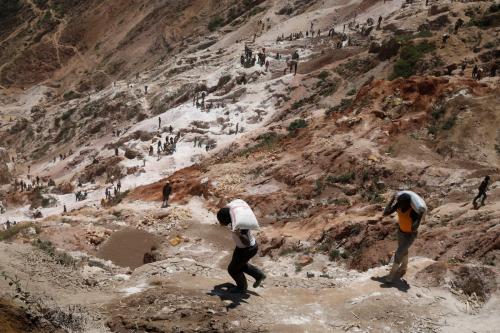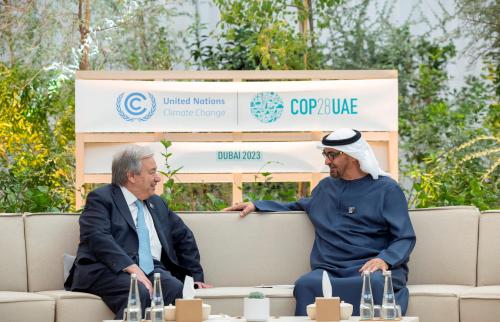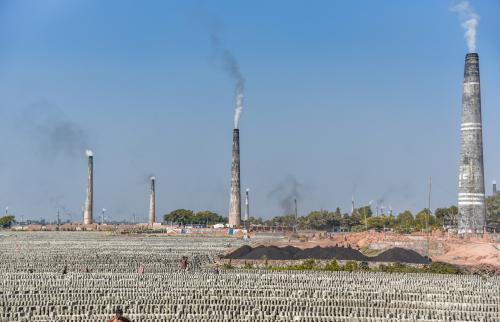Editor’s Note: While attending the negotiations on the Sendai Framework for Disaster Risk Reduction 2015-2030, Walter K
ä
lin reflects on how the newly adopted framework may impact the millions of people displaced by natural disasters each year.
It’s 7 pm on March 18, 2015 here in Sendai where negotiations on the Sendai Framework for Disaster Risk Reduction 2015-2030 should have been concluded many hours ago. I see the screens announce that the Closing Ceremony, originally scheduled for 10 am is “further delayed.” While negotiators who already had spent several nights in the meeting room are still struggling to reach consensus on a long list of issues, the 200 children who for weeks had been looking forward to singing and dancing at the closing event are sent back home. One of the remaining contentious issues is displacement.
The original pre-draft of the post-2015 framework for disaster risk reduction circulated in Geneva last summer contained only a passing reference to the topic. States affiliated with the Nansen Initiative (which I act as Envoy of the Chairmanship for), a state-led process to build consensus bottom-up on how best to address disaster-induced cross-border displacement together with the International Organization for Migration and UNHCR, worked to introduce a series of draft texts related to displacement, migration, and relocation. However, when the negotiations moved to Sendai, several paragraphs remained heavily bracketed, and most issues could not be solved during negotiations there. So when very late in the evening the news broke that the text was ready for adoption, I wondered whether references to the disaster-related displacement had survived.
In fact, disaster risk reduction is highly relevant for displaced persons. Between 2008 and 2013, sudden-onset disasters such as earthquakes, cyclones and floods displaced an estimated 164 million people. Most of them became internally displaced persons, such as the more than four million displaced survivors of Typhoon Haiyan/Yolanda in 2013. Global estimates of people displaced by slow-onset disasters such as drought are not known, but likely to number in the millions. In the context of the Horn of Africa drought crisis and instability within Somalia, some 1.3 million Somalis were internally displaced, with 290,000 people seeking refuge in neighboring countries during the 2011/2012 famine. In Haiti, more than a million people were internally displaced following the 2010 earthquake and an estimated 100,000 – 200,000 people left Haiti for the neighboring Dominican Republic and other countries in the region. Climate change is predicted to increase the intensity of hydro-meteorological disasters in the future, making even higher levels of displacement likely.
These large-scale displacements have a devastating effect on people and create complex challenges for recovery and reconstruction efforts.
These large-scale displacements have a devastating effect on people and create complex challenges for recovery and reconstruction efforts. Displacement could often be avoided or at least mitigated by taking appropriate disaster risk reduction measures. To address displacement in a specific and detailed manner in the Sendai Framework on Disaster Risk Reduction 2015 – 2030 (the Framework) was therefore recognized by many as a must.
Now a few days later, what is the final outcome of the negotiations in Sendai? Negotiators from Bangladesh, Norway, the Philippines, and Switzerland in particular did a great job during the World Conference on Disaster Risk Reduction in fighting hard and ultimately succeeding to get important language on human mobility into the Framework.
The Preamble specifically acknowledges the large number of disaster displaced persons in recent years as one of the devastating effects of disasters. One of the seven targets of the Framework is to “substantially reduce the number of affected people globally by 2030, aiming to lower the average global figure per 100,000 between 2020-2030 compared to 2005-2015.” Affected persons certainly include internally displaced persons (IDPs), but looking at the yearly average of 27.5 million newly displaced persons in the past six years as reported by the Internal Displacement Monitoring Center, this figure is clearly not ambitious enough.
Like the 1998 Guiding Principles on Internal Displacement, the Framework stresses that the primary responsibility for the prevention and reduction of disaster risk lies with States. At the same time, the Framework emphasizes the fact that this responsibility can only be carried out through cooperation with other States at bilateral, regional, and global levels. While not referencing the Guiding Principles, the Framework highlights that disaster risk management aims at “protecting persons and their property, health, livelihoods, and productive assets, as well as cultural and environmental assets, while promoting and protecting all human rights.” This provides the Guiding Principles and its human rights based approach with an important entry point to disaster risk reduction strategies, programs and projects. The importance of participation of IDPs in decisions affecting them as highlighted throughout the Guiding Principle is specifically acknowledged in the Framework by stressing that disaster risk reduction “requires empowerment and inclusive, accessible and non-discriminatory participation, paying special attention to people disproportionately affected by disasters.” There is no doubt that IDPs fall within the latter category.
According to Guiding Principles 5, States have to prevent displacement in accordance with their human rights obligation to protect people against known and foreseeable risks for their life, limb, and health. Much of the Sendai Framework deals with preventing natural and other hazards becoming disasters by reducing associated risks. In this regard, measures such as developing and disseminating risk maps to communities at risk and to develop policies addressing identified risks; to prevent people to move into risk zones or relocating communities already living in such zones; and to prepare for evacuations are particularly important. With regard to protection of IDPs during displacement, the Framework underlines the need to prepare for “ensuring rapid and effective response to disasters and related displacement, including access to safe shelter, essential food and non-food relief supplies.” Building resilience is another important topic for the Framework. In this context, the Framework encourages States to adopt, at national and local levels, “policies and programs addressing disaster-induced human mobility to strengthen the resilience of affected people and that of host communities as per national laws and circumstances.” The mention of host communities is very important as they are affected by displacement, too. Finally, displaced persons in need of durable solutions may profit from the call to integrate “temporary settlements for persons displaced by disaster” into post-disaster recovery.
The Framework avoids the notion of “internally” displaced persons even though the majority of disaster displaced people remain within their own country.
Interestingly enough, the Framework avoids the notion of “internally” displaced persons even though the majority of disaster displaced people remain within their own country. While reference to IDPs was opposed by a few states, the compromise language found opens the way for interpreting, where adequate, relevant provisions as to cover both IDPs and people displaced across borders. Cross-border displacement is specifically mentioned in a provision calling for trans-boundary cooperation to address displacement risks in areas with common eco-systems such as river basins or coastlines.
While the Sendai Framework falls short of expectations in several regards, it is highly relevant for more effectively tackling the multiple challenges of disaster-related displacement. Whereas the Hyogo Framework for Action 2005-2015 only contained a passing reference to displacement, the Sendai Framework, while non-binding but highly authoritative, provides an important basis for improving the protection of disaster displaced persons. What is needed now to make the Framework effective is investment into capacity building at all levels as well as mainstreaming displacement and related human mobility issues into regional, national, and local disaster risk reduction strategies. Overall, the Sendai Framework offers a wealth of opportunities for those dealing with displacement issues, including the Brookings Project on Internal Displacement, to further engage and establish closer ties with the disaster risk reduction community to strengthen the protection of IDPs worldwide.



Commentary
Sendai Framework: An important step forward for people displaced by disasters
March 20, 2015